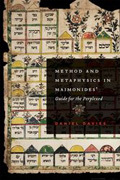
This book investigates the substance and presentation of major metaphysical themes in Maimonides' Guide for the Perplexed. Using rigorous philosophy it seeks to refute the view that the Guide hides an ''esoteric'' philosophical meaning beneath a traditional veneer, and offers a new explanation of his esotericism. Maimonides' Guide for the Perplexed is one of the most discussed books inJewish history. Over 800 years after the author's death it remains disputed with readers seeking secret philosophical messages behind its explicit teaching, a quest fueled partly by Maimonides' own statement that certain parts of the Guide are based upon ideas that conflict with other parts. Many who adhere to an 'esoteric' reading of the Guide profess to find these contradictionsin Maimonides' metaphysical beliefs. Through close readings of the Guide, this book addresses the major debates surrounding its secret doctrine. It argues that perceived contradictions in Maimonides' accounts of creation and divine attributes can be squared by paying attention to the various ways in which he presented hisarguments. Furthermore, it shows how a coherent theological view can emerge from the many layers of the Guide. But Maimonides' clear declaration that certain matters must be hidden from the masses cannot be ignored and the kind of inconsistency that is peculiar to the Guide requires another explanation. It is found in the purpose Maimonides assigns to the Guide: scriptural exegesis. Ezekiel's Account of the Chariot, treated in one of the most laconic sections of theGuide, is the subject of the final chapters. They offer a detailed expositionof Maimonides' interpretation, the deepest ''secret of the Torah,'' which, inMaimonides' works, shares its name with metaphysics. By connecting the visionwith currents in the wider Islamic world, the chapters show how Maimonides devised a new methodof presentation in order to imitate scripture's multi-layered manner of communication. He updated what he took to be the correct interpretation of scripture by writing it in a work appropriate for his own time and to do so he had to keep the Torah's most hidden secrets. Chapter One: Interpreting Maimonides in his Multiple ContextsChapter Two: A Dialectical Topic: CreationChapter Three: Necessity and the LawChapter Four: Religious Language (A): Negative Theology and Divine PerfectionsChapter Five: Religious Language (B): Perfections and SimplicityChapter Six: Religious Language (C): God's Knowledge as a Divine PerfectionChapter Seven: ''Secrets of the Torah'': Ezekiel's Vision of the ChariotChapter Eight: The Scope and Accuracy of Ezekiel's ProphecyChapter Nine: ''A Kind of Conclusion''Bibliography
- ISBN: 978-0-19-976873-8
- Editorial: Oxford University
- Encuadernacion: Cartoné
- Páginas: 224
- Fecha Publicación: 03/11/2011
- Nº Volúmenes: 1
- Idioma: Inglés
